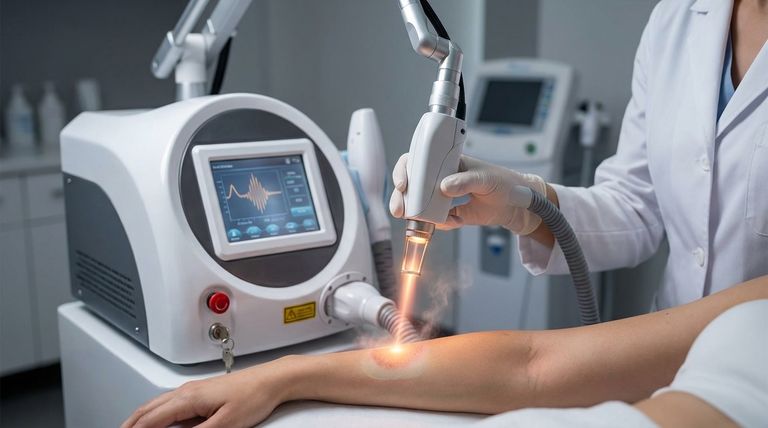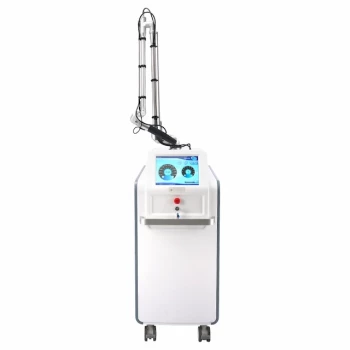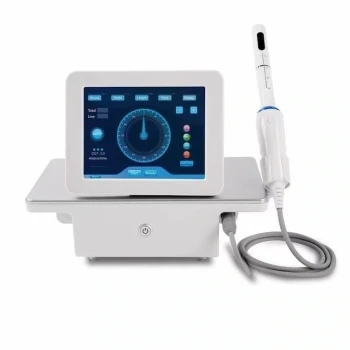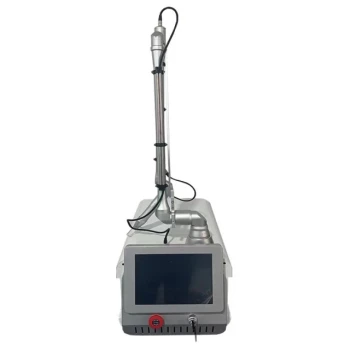At its core, the YAG laser's mechanism of action is photothermal. This means it generates a highly focused beam of near-infrared light that, upon being absorbed by tissue, is converted into intense, localized heat. This thermal energy is what produces the desired clinical effect, whether it's precisely cutting, coagulating, or vaporizing (ablating) the target tissue.
The term "YAG laser" most often refers to the Neodymium-doped Yttrium Aluminum Garnet (Nd:YAG) laser, but its mechanism is not singular. The primary effect is determined by how the laser's energy is delivered over time. It can be either photothermal (slow heating) for bulk tissue removal or photodisruptive (a micro-explosion) for precise, non-thermal cutting.

The Foundation: Light-Tissue Interaction
### The YAG Crystal and its Wavelength
The term "YAG" refers to the crystal host, Yttrium Aluminum Garnet. This crystal is typically "doped" with an active element, most commonly Neodymium (Nd), creating the Nd:YAG laser.
This laser configuration produces a specific wavelength of light, primarily 1064 nanometers (nm). This places it in the near-infrared portion of the electromagnetic spectrum, which is invisible to the human eye.
### Why the 1064 nm Wavelength Matters
The 1064 nm wavelength is critical because it has relatively low absorption by the primary chromophores in biological tissue, such as water and melanin.
This low absorption allows the laser energy to penetrate more deeply into tissue compared to other common medical lasers. This property is fundamental to its range of applications.
The Two Primary Mechanisms of Action
The true mechanism of the Nd:YAG laser depends entirely on the pulse duration—how quickly the energy is delivered. This gives rise to two distinct physical interactions with tissue.
### Mechanism 1: Photothermal Ablation (Continuous Wave / Long Pulse)
When the laser is operated in a continuous wave or long-pulse mode (durations of milliseconds), the mechanism is purely photothermal.
Energy is delivered slowly enough for the tissue to absorb it as heat. The temperature rises rapidly, leading to the denaturation of proteins, coagulation of blood vessels, and ultimately, the vaporization and removal of tissue. Think of it as a microscopic, incredibly precise magnifying glass focusing sunlight to burn a target.
This is the mechanism used for bulk tissue removal, tumor ablation, and procedures requiring hemostasis (stopping bleeding), as the heat effectively cauterizes blood vessels as it cuts.
### Mechanism 2: Photodisruption (Q-Switched / Short Pulse)
By using a technique called Q-switching, the laser's full energy can be released in an extremely short, high-power pulse (lasting only nanoseconds). This completely changes the mechanism to photodisruption.
The immense power density—billions of watts per square centimeter—is delivered so quickly that heat cannot dissipate. Instead, it rips electrons from atoms at the focal point, creating a state of matter called a plasma.
This plasma bubble expands at supersonic speed, generating a powerful acoustic shockwave. It is this mechanical shockwave, not heat, that tears and disrupts the tissue. The process is akin to creating a controlled micro-explosion at a single point. This is the mechanism used in ophthalmology to cut the posterior lens capsule without any thermal damage.
Understanding the Trade-offs
### The Risk of Collateral Damage
The main trade-off of the photothermal mechanism is the risk of collateral thermal damage. Because the 1064 nm wavelength penetrates deeply, heat can spread beyond the target zone, potentially harming adjacent healthy tissue.
The zone of thermal coagulation around the ablated area is a direct and often unavoidable side effect of this mechanism.
### The Precision of Photodisruption
Photodisruption, by contrast, is incredibly precise and non-thermal. The mechanical effect is confined to a tiny area, and the process happens too fast for significant heat to spread.
However, the generated shockwave must be carefully managed. If not precisely focused, the mechanical force can have unintended consequences on nearby delicate structures.
### Versatility vs. Specificity
Because the 1064 nm wavelength is not strongly absorbed by any single component, the Nd:YAG laser is a versatile "workhorse." However, for applications requiring highly selective targeting (like removing a red birthmark), a laser with a wavelength specifically absorbed by blood (like a Pulsed Dye Laser) may be more efficient.
Matching the Mechanism to the Clinical Goal
To apply the YAG laser effectively, you must first define the desired physical interaction with the tissue.
- If your primary focus is deep tissue coagulation or bulk thermal ablation: You will leverage the photothermal mechanism, typically with a continuous wave or long-pulse Nd:YAG laser.
- If your primary focus is precise, non-thermal cutting of transparent structures: You will rely on the photodisruptive mechanism of a Q-switched Nd:YAG laser.
- If your primary focus is cutting tissue with simultaneous hemostasis: The photothermal effect is ideal, as the heat that coagulates blood vessels is an intrinsic part of the cutting process.
Understanding whether the desired interaction is thermal or mechanical is the key to mastering the YAG laser's application.
Summary Table:
| Mechanism | Pulse Duration | Primary Effect | Key Clinical Applications |
|---|---|---|---|
| Photothermal | Continuous Wave / Long Pulse (ms) | Tissue heating, vaporization, coagulation | Bulk tissue removal, tumor ablation, procedures requiring hemostasis |
| Photodisruption | Q-Switched / Short Pulse (ns) | Mechanical shockwave (non-thermal) | Precise cutting of transparent structures (e.g., posterior capsule in ophthalmology) |
Ready to leverage the precision of YAG laser technology in your practice?
BELIS specializes in professional medical aesthetic equipment, serving medical aesthetics clinics and premium beauty salons. Our advanced Nd:YAG laser systems are engineered for reliability, safety, and superior clinical outcomes, whether your focus is deep tissue coagulation or precise, non-thermal cutting.
Contact our experts today to find the perfect YAG laser solution for your clinical needs and enhance your treatment offerings.
Visual Guide

Related Products
- Q Switch Nd Yag Laser Machine Tattoo Removal Nd Yag Machine
- Clinic Use IPL and SHR Hair Removal Machine with Nd Yag Laser Tattoo Removal
- Diode Laser SHR Trilaser Hair Removal Machine for Clinic Use
- Clinic Diode Laser Hair Removal Machine with SHR and Trilaser Technology
- 7D 12D 4D HIFU Machine Device
People Also Ask
- What are the disadvantages of Q switching? Trade-offs in Pulse Control, Cost, and Beam Quality
- Is Q-Switch laser safe for skin? Achieve Precise, Non-Invasive Skin Rejuvenation Safely
- How does the Nd:YAG laser work? Unlocking Deep-Tissue Precision for Medical Aesthetics
- What are Q-switched lasers commonly used for? Remove Tattoos & Pigment with Precision
- What are the side effects of Q-switch laser? A Guide to Safe, Effective Treatment



















